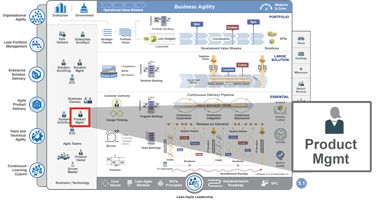
Delighted about Product Management
Customers deserve the best experiences. Business stakeholders deserve winning outcomes. Teams deserve to build and evolve innovative solutions. Today’s enterprises need people who can apply market insights, business strategy, technology strategy, and Lean-Agile thinking to define products and services that delight all those who build, support, fund, and consume them.
These superheroes, collectively, are Product Management—a critical function in SAFe that is responsible for defining desirable, viable, feasible, and sustainable solutions that meet customer needs and for supporting development across the entire product life cycle.
We are delighted to announce a special update to the Product Management article to better convey the essential characteristics of this role.
We have expanded Product Management’s responsibilities into the five areas below, recognizing that delivering sustainable value involves much more than simply getting products built, shipped, and supported.
We have clarified the primary job to be done by Product Management. In addition to defining valuable solutions, the glossary definition, which appears at the top of the article, now includes active involvement in the ongoing evolution of those solutions.
We have updated Product Management’s key collaborations, emphasizing that Product Managers not only apply specialized skills within their domain but work closely with others in the organization to align on outcomes, steer the ART, and continually evolve solutions.
Finally, we have streamlined the other, more peripheral aspects of the role to emphasize the characteristics above. However, the article still explains the differences between internal and external customers and appreciates that Product Managers are often customers of each other when developing composite solutions.
We hope you’ll be delighted with these updates and encourage you to treat this and the recently updated Product Owner article as a complementary set.
Enjoy!
—Marc and the Framework Team




Sherilyn Segrest
One thing I expected to see was a sixth spoke on the wheel that talks about how product managers use data from what they have previously delivered as an input into the future roadmaps. In my experience, that focus on data-driven adoption is what differentiates modern day product management from the way we did IT before we product managed it. It really is holding the product manager responsible for the adoption of the thing developed, and encouraging them to learn from what was delivered for ongoing improvements and adoption.
marc.rix@scaledagile.com
Thanks, Sherilyn. Although data-driven practices don’t appear as a sixth responsibility area, they are hugely important and peppered throughout the article. For example, ‘exploring markets and users’ and ‘connecting with the customer’ involve collecting objective feedback about market preferences and trends, helping to establish product-market fit early. As part of ‘delivering value,’ Product Management measures product performance in-market against expected outcomes, then folds those learning back into product strategy. The other areas include responsibilities that involve various forms of fact-gathering too.
Charles McBride
Nice update to the Product Management article.
One small thought to consider. In the Product Management article Figure 1 it shows the System Arch as a standalone figure working with Product Management, however in many organizations its more than one person. Just like it is implied around Product Management as more than one individual. The big picture implies plural with the System Arch/Eng icon. I point this out as it implies one person in that figure and is not the case in many organizations. It would be great to have the same icon in Figure 1 for System Architect as we see on the big picture.
It is well stated later in the write-up about PM’s working with System Architects.
Great update!
marc.rix@scaledagile.com
Thanks for the comment, Charles. You’re absolutely right. System architecture is often a function rather than a single individual, in which case Product Management may collaborate with multiple System Architects to help steer the ART.